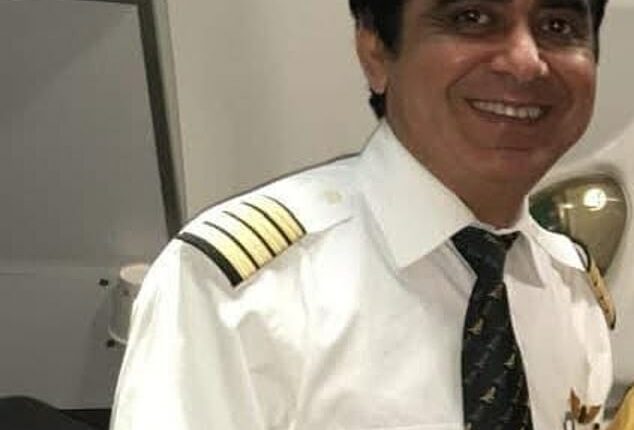The captain of an Air India plane that crashed last month killing 260 people had promised he would return home hours before jetting off on the doomed flight.
Captain Sumeet Sabharwal, 56, was the senior pilot onboard the Boeing 787 Dreamliner that plummeted into a residential area in Ahmedabad on June 12, killing 241 people on board and 19 people on the ground.
The veteran aviator, who had more than 8,200 hours in the cockpit, is being looked into by investigators over suggestions he turned off the plane’s fuel switches, causing it to lose power.
The plane had set off to London at 1:38pm and remained airborne for about 30 seconds before losing power and falling to the ground. Upon impact, it was engulfed by a huge fireball, claiming the lives of all but one person on board.
A preliminary report into the tragedy revealed that before the crash, two fuel switches – which are used to start or shut down the engines and are typically left on during flight – were moved from ‘Run’ to ‘Cutoff’, depriving the engines of fuel.
The report also revealed there had been confusion in the cabin when Sabharwal and his co-pilot Clive Kunder, 28, realised the fault, before desperate attempts were made to flick them back.
Sources close to the investigation believe recordings of the conversation from the Boeing’s black box support the view that the captain cut the flow of fuel to the plane’s engines.
But, Sabharwal’s final words to a security guard at his apartment complex, where his elderly father also lived, would suggest otherwise. ‘Please, take care of papa. I will be back soon,’ he reportedly said just hours before the crash.

Investigations into the Air India plane crash are reportedly examining Captain Sumeet Sabharwal’s (pictured) medical records

Seconds after taking off on June 12, two fuel switches in the cockpit of Air India Flight 171 were turned off, a preliminary report revealed

The plane momentarily disappeared from view behind trees and buildings before a massive fireball erupted on the horizon in this horrifying clip
Friends and colleagues also reject the idea Sabharwal was responsible, claiming he was a ‘gentle soul’ and an ‘ace pilot’ who had never been involved in any major incident prior to the crash.
Neil Pais, 61, a former colleague of Sabharwal, told The Telegraph he was ‘one of the nicest people you could ever hope to fly with’.
‘He had absolutely no airs about himself, so humble, so respectful. Always a smile when he spoke to you,’ he added.
‘I never once saw him raise his voice or lose his temper. And yet he never compromised on work or safety. If there was an issue, he’d point it out, but always in the nicest possible way.’
Another colleague and close friend, Captain Kapil Kohal, said Sabharwal was a ‘hero’ with a ‘gentle soul’.
Despite his nickname of ‘Sad Sack’, given because of his ‘melancholic eyes’, Sabharwal was ‘deeply charismatic and always ready to help,’ he added.
But the sadness noticed by his peers was resultant of a deeper tragedy.
Sabharwal had struggled to come to terms with the death of his mother in 2022 and in the wake of her passing had separated from his wife and moved from Delhi to Mumbai, to be closer to his elderly father, Pushkaraj.

The back of Air India flight 171 is pictured at the site after it crashed in a residential area near the airport in Ahmedabad on June 12, 2025

Investigations into the tragic crash (pictured) have begun to analyse the behaviour of the pilot
Investigations into the tragic crash have reportedly begun to analyse Sabharwal’s behaviour after ‘several’ Air India pilots allegedly confirmed he suffered from poor mental health.
He is understood to have taken bereavement leave after his mother’s death. Although it is believed that he had been ‘medically cleared’ by Air India prior to the fatal crash.
Friends also revealed Sabharwal had considered retiring as a pilot to help care for his 90-year-old father full time.
According to Sunil Lokhande, the security guard at his apartment complex in Mumbai, Sabharwal would often visit his father ‘for two or three days’ and take him for evening walks.
The pilot would also buy vegetables and fruits, which he would share with Lokhande and would also give him money to buy meals.
Such details bring further questions as to why the pilot might have decided to cutoff the fuel switches only seconds after takeoff, a move described by aviation experts as ‘absolutely bizarre.’
While there was no cockpit video recording definitively showing which pilot flipped the switches, early assessments by U.S. officials claim the weight of evidence from the conversation points to the captain being responsible .
Citing U.S. pilots familiar with the AAIB report, the Wall Street Journal reported this week that ‘as the pilot actively flying, [First Officer] Kunder likely would have had his hands full pulling back on the Dreamliner’s controls at that stage of the flight’.

Pictures show the devastation after the plane crashed into a residential building. In Powai, Mumbai, one of Captain Sabharwal’s former colleagues told the Daily Telegraph that he was a ‘thorough gentlemen’
On Sunday, a preliminary report released by the Indian authorities led to questions about why the pilot would have manually turned the switches off – and whether it was a deliberate act or a catastrophic mistake.
The report said: ‘In the cockpit voice recording, one of the pilots is heard asking the other: why did he cut off? The other pilot responded that he did not do so.’
Pilots will turn the fuel switches on and off at the correct times in every flight, but this time the fuel was cut off straight after takeoff and the landing gear was not raised.
The co-pilot was flying the aircraft at the time of takeoff while the captain was monitoring.
The report added that the switches were flipped back to ‘run’ seconds afterwards, which started the process of relighting the engines.
One of the engines had relit but had not gained power while the other was in the process of regaining power.
At the crash site, but switches were found in the ‘run’ position.
Before the flight, both pilots had an adequate rest period and were found ‘fit to operate’ following a breath analyser test, the report said.

People look at the debris of an Air India plane crashed in Ahmedabad of India’s Gujarat state. Before the flight, both pilots had an adequate rest period and were found ‘fit to operate’ following a breath analyser test, the report said

A graphic displaying how the lever on the Boeing 787 Dreamliner works

After losing altitude, it came into contact with Building A at 293ft at the angle illustrated above
There were no dangerous goods on the plane and the weight was ‘within allowable limits’.
Fuel samples taken from the tanks were tested and found to be ‘satisfactory’ and there was ‘no significant bird activity’ observed in and around the flight path of the aircraft.
But Mr Ranganthan previously suggested it may have been deliberate.
Each lever has to be pulled upwards to be unlocked, before it can be flipped and they also have further protective guard brackets to safeguard against any bumps and nudges.
Explaining that he believed it ‘had to be done manually’, Mr Ranganathan told NDTV of the fuel levers: ‘The fuel selectors they aren’t the sliding type they are always in a slot.
‘They are to pull them out or move them up or down, so the question of them moving inadvertently out of off position doesn’t happen. It’s a case of deliberate manual selection.’
He later said ‘nothing else’ would explain why both switches were moved into the off position just after take off, alleging: ‘It had to be deliberately done.’
When questioned if he was suggesting one of the pilots ‘deliberately’ switched off the fuel lever, while fully aware of the possibility of a crash, he answered: ‘Absolutely’, before asserting they were looking at a potential ‘pilot-induced crash’.

CCTV footage (pictured) from the airport shows the Ram Air Turbine (RAT) being deployed as the aircraft lifts off. Ameen Siddiqui, 28, whose brother-in-law, Akeel Nanabawa, died alongside his wife and their four-year-old daughter said: ‘This report is wrong. We don’t accept it’

Firefighters work at the site of the crash near Sardar Vallabhbhai Patel International Airport
But relatives of some of the victims of the crash have accused the airline and the Indian government of trying to blame the pilots for the crash.
Ameen Siddiqui, 28, whose brother-in-law, Akeel Nanabawa, died alongside his wife and their four-year-old daughter said: ‘This report is wrong. We don’t accept it.’
‘It’s a cover-up to protect Air India and the government,’ Mr Siddiqui told The Telegraph from Surat, south of Ahmedabad, where the plane crashed.
‘They want to blame dead pilots who can’t defend themselves. How can the fuel switches end up turning off at a critical moment, either through pilot error or a mechanical fault?
CCTV footage from the airport showed that the ram air turbine, known as the RAT, was deployed shortly after takeoff.
The RAT acts as a backup power source during emergencies and will deploy in cases of complete power failure.
The report said two minutes after takeoff, one of the pilots transmitted: ‘Mayday, Mayday, Mayday’.
In December 2018 the US air regulator Federal Aviation Administration (FAA) warned airlines that fuel switches had been installed in some Boeing 737s ‘with the locking feature disengaged’.

A family member cries upon hearing the news of her brother who died when the Air India Boeing 787 Dreamliner plane crashed in Ahmedabad, India, June 12, 2025. An Air India spokesperson previously said: ‘Air India stands in solidarity with the families and those affected by the AI171 accident’
‘If the locking feature is disengaged, the switch can be moved between the two positions without lifting the switch during transition, and the switch would be exposed to the potential of inadvertent operation,’ the FAA warned in a Special Airworthiness Information Bulletin.
‘Inadvertent operation of the switch could result in an unintended consequence, such as an in-flight engine shutdown.’
It recommended airlines inspect the switches, including ‘whether the fuel control switch can be moved between the two positions without lifting up the switch’.
The airworthiness concern was not considered an unsafe condition that would warrant a legally enforceable regulation to correct unsafe conditions.
Air India has suggested such inspections were not carried out because the FAA’s bulletin was ‘advisory and not mandatory’.
An Air India spokesperson previously said: ‘Air India stands in solidarity with the families and those affected by the AI171 accident. We continue to mourn the loss and are fully committed to providing support during this difficult time. We acknowledge receipt of the preliminary report released by the Aircraft Accident Investigation Bureau (AAIB) today, 12 July 2025.
‘Air India is working closely with stakeholders, including regulators. We continue to fully cooperate with the AAIB and other authorities as their investigation progresses.
‘Given the active nature of the investigation, we are unable to comment on specific details and refer all such enquiries to the AAIB.’








